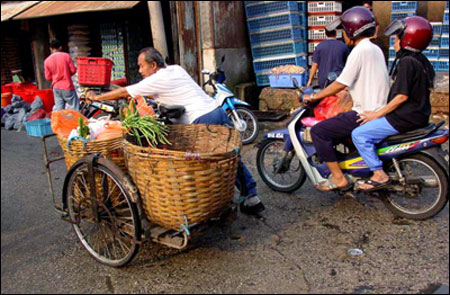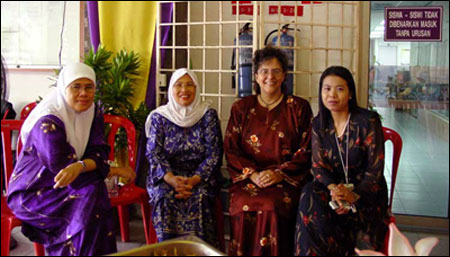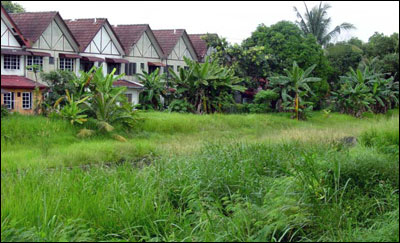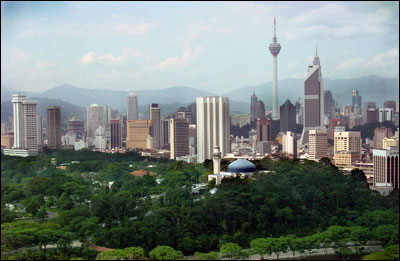
From the back of a small white van, a man named Muhammad sold rojak in takeaway containers. The shopping mall on the other side of the parking lot boasted a KFC, Pizza Hut, and Starbucks. A big McDonald’s did a lively business one block away. But Muhammad usually had at least three or four customers lined up at his truck, waiting for him to scoop their orders from his assortment of plastic tubs.
The mixture of cucumber and pineapple chunks included various pieces of jicama, mango, apples, bits of puffy fried tofu, and bean sprouts. The sauce tasted strongly of shrimp paste cut with sugar, hot chilies, and lime juice. A generous sprinkling of chopped peanuts completed the dish.
Like most Malaysians, Muhammad thought a white person like me would not like rojak. “Spicy,” he warned me politely. It’s not for everyone.
Few people in the United States know anything about Malaysia. Why should they? The peaceful Southeast Asian country is half a world away from either one of our shores, its history obscure to us.
“They’re Buddhists there, aren’t they?” a university colleague asked me as I rushed around the office, making last-minute preparations near the end of 2004 to leave for an eight-month stay. No, he must have been thinking of Thailand.
Scuba divers, however, know Malaysia — its clean, white sand and clear, tropical waters. Europeans fly down for beach holidays. Saudis come during the hottest part of the year, Western-looking men in jeans and polo shirts, with multiple black-robed wives in tow — they find both the Muslim culture and high humidity welcoming.
Islam came to the lands occupied by Malays certainly before the 14th century, and maybe as early as the ninth century, 200 years after the death of the prophet Mohammed. One sees evidence of Islam everywhere, from the halal Chinese restaurants that serve no pork, to the sarong-clad boys on motorbikes converging on mosques each Friday afternoon. The official state religion is Islam, and the country has an official doctrine of tolerance and religious freedom.
I met Maria and her family in Kuching, a city in East Malaysia, on the island of Borneo. They enthusiastically introduced me to paper dosa, a gigantic crispy pancake imported from southern India. Maria’s daughter was waiting to hear whether she had won a place in the university, a process based on academic testing, controlled by the national government. Why should she worry? I asked, assuming that because the family is Iban, one of the native tribes of Borneo, the girl would be assured a place.
“You’ll get a place. You are bumiputera,” I said, using the word assigned to all Malay ethnic groups, regardless of religion.
“We are second-class bumiputera,” Maria said dryly. “We are not Muslim.”
The winds of the southwest monsoon brought Arab and Indian traders to the Strait of Malacca hundreds of years ago. The Chinese merchants came in on the winds of the northeast monsoon. During the inter-monsoon season, the traders waited in port for the wind to turn to blow them home again, their ships laden with pepper, cloth, gold, tin, products of the wet forests, and sinuous inland rivers. In the meantime, they mingled — with each other and with the Malays, Javanese, and Sumatrans who lived there year-round.
Great Hindu civilizations flourished there — Srivijaya and Majapahit — empires never mentioned in my American schoolbooks. Much later came the Portuguese sailors, then the Dutch, and finally, the British.
I went on a trekking excursion in Borneo, and there was one Englishwoman in our group, a nurse in her early 30s. As we sprawled on a beach by the Sulu Sea, shaded by leaning palm trees, she said, “I’ve always wanted to visit Borneo. It’s been my dream since I was a little girl.” I mulled over the idea that a child in England, born almost 30 years after the end of World War II, had grown up on stories of the exotic lands once controlled by the British Empire.
My friend Kiranjit was born and grew up in Kuala Lumpur, the national capital. She lives there still. Of her 12 brothers and sisters, all but two have moved abroad, either to Australia or to England. Their parents were Sikh, immigrants from India.
“Why should they raise their children in a place that doesn’t want them?” she said, explaining the exodus. Even more so than Maria’s daughter, their chances of winning places at a public university are low.

On another day, I visited Universiti Kebangsaan Malaysia (UKM) and met with a group of lecturers. “You know, people have their loyalty to their home country,” a UKM professor told me as we drank coffee and munched on curry puffs. “People like your friend Kiranjit — of course, her real home is in India.” When I explained that I had a different impression, the professor was quite surprised.
I felt exasperated by his assumption that my friend was allied with a country she has never lived in. “She’s Malaysian,” I said. “She speaks Malay and English. She doesn’t know any Indian languages.” He seemed pleased by the idea that my friend identifies herself as a Malaysian — but also a bit perplexed. I was reminded of the expression on the face of Muhammad, the rojak vendor, as he watched me smile after I had chewed and swallowed the spicy fruit salad.
Chatting with that group of Malay professors, I wondered whether the fabulous rojak culture of Malaysia had yet to be digested by their generation, the generation born in the years just before and after independence. They ate it, drank it, served it at their own dinner tables, but they seemingly did not realize that it is the variety of flavors and textures that makes their country great. When the rojak does not include mango, I really miss it.

Before 1957, there was no “Malaysia.” On the Malay Peninsula and on the island that foreigners call Borneo lived various groups of people with strong ethnic or tribal identities. Sultans controlled, more or less, certain geographic territories, but borders are hard to draw inside jungles, and even harder to enforce. Chinese immigrants worked in tin mines. Indian immigrants tapped the rubber trees on plantations. Malays, under the British policy of “divide and rule,” took jobs in the civil service. As in many parts of Asia, Africa, and South America, the recipe for Malaysia followed a European logic.
My friend Siti closed the door to her office, unclasped an ornamental pin near her throat, and removed her hijab, the Muslim head covering which the Malays call tudung. She pushed at her hair with her fingertips. “It gets so hot, Prof,” she said. She told me that she did not wear the scarf until she was married, and she did not ask her daughters to wear the scarf, but rather left the decision to them.
“All this scarf-no scarf business — we didn’t have that when I was young,” Siti said. “Then we were all in school together, Chinese and Malay, some Indian girls too. And we went to each other’s houses, lah. We didn’t think anything about eating in the Chinese girl’s kitchen. Her mom made us some mee, lah, and we just ate it.”
This August, Malaysia will celebrate the 50th anniversary of merdeka, their independence. They have been inventing a new nation for 50 years. They started with a diverse collection of cultures, beliefs, customs, and languages, but that’s hardly new. Their country is the product of several hundred years of collaboration and trade, extending from the western edge of Arabia to the southern tip of India (and Sri Lanka) and onward to the eastern edge of China.
The great beauty of Malaysian culture comes out of this mixing of people, in which they maintain the pure flavor of their ancestors’ religions, languages, clothing, and customs — like the separate fruits in rojak — but at the same time, they are transformed by the sauce, the spicy-tart flavor that brings all of them together. If they try to separate, to reinvent a purity that vanished centuries ago, I worry that they will lose the unique strength they have gained from being mixed.

- Follow us on Twitter: @inthefray
- Comment on stories or like us on Facebook
- Subscribe to our free email newsletter
- Send us your writing, photography, or artwork
- Republish our Creative Commons-licensed content

